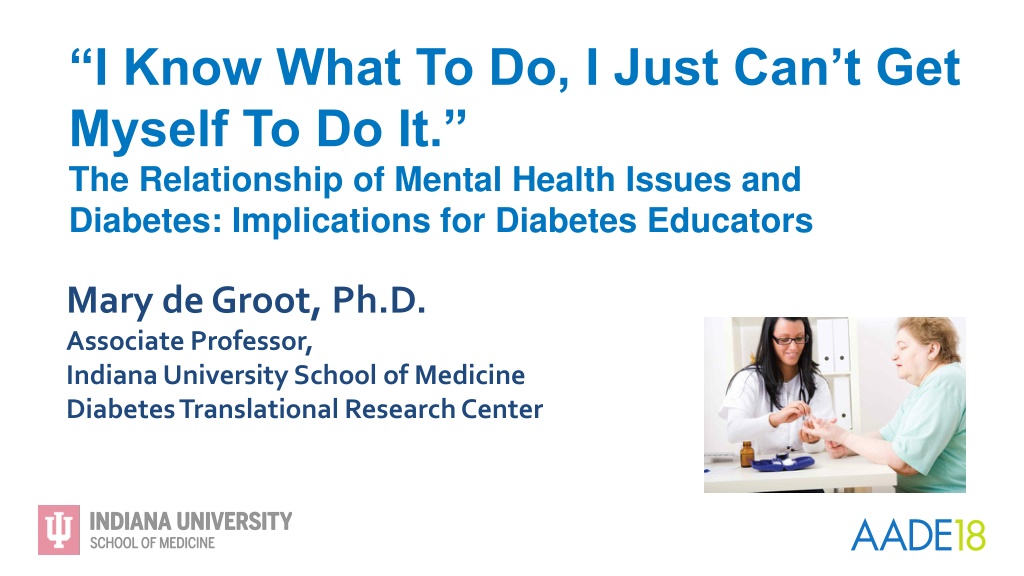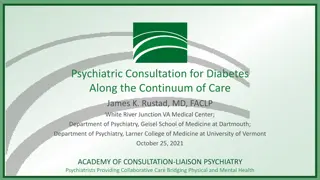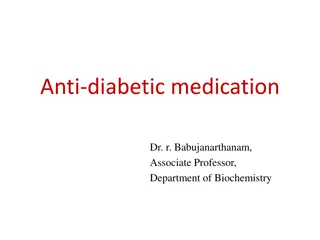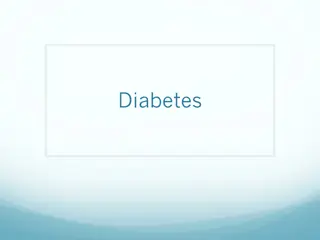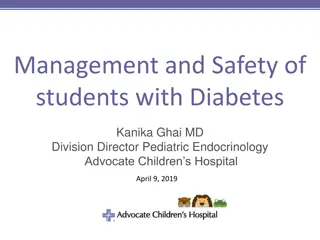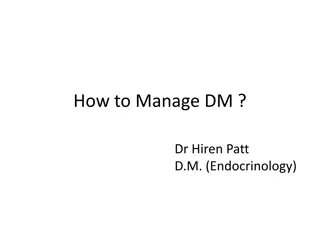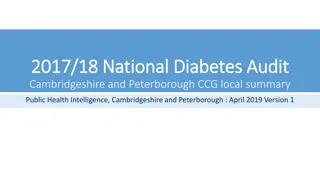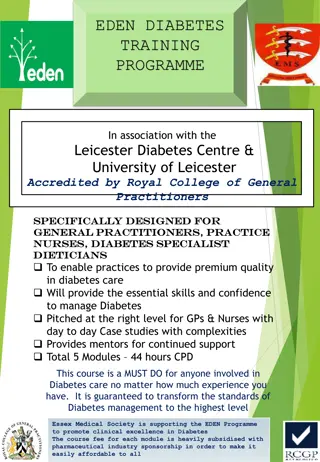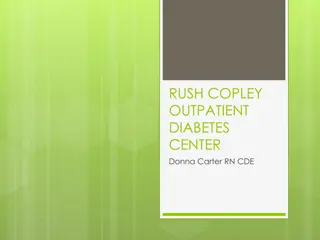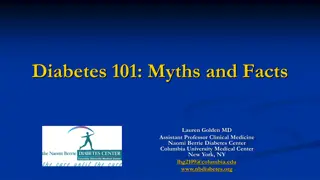Understanding the Relationship Between Mental Health and Diabetes: Insights for Educators
Exploring the link between mental health issues and diabetes, this presentation by Dr. Mary de Groot discusses the implications for diabetes educators. It delves into the prevalence of mental health conditions in people with diabetes, screening, treatment options, and interrelationships between diabetes-related distress, depression, anxiety, and disordered eating behaviors. The continuum of constructs related to psychological distress and depressive symptoms is also examined, along with criteria for depression according to DSM-V. The content highlights the challenges individuals may face in managing diabetes alongside mental health issues.
Download Presentation

Please find below an Image/Link to download the presentation.
The content on the website is provided AS IS for your information and personal use only. It may not be sold, licensed, or shared on other websites without obtaining consent from the author. Download presentation by click this link. If you encounter any issues during the download, it is possible that the publisher has removed the file from their server.
E N D
Presentation Transcript
I Know What To Do, I Just Cant Get Myself To Do It. The Relationship of Mental Health Issues and Diabetes: Implications for Diabetes Educators Mary de Groot, Ph.D. Associate Professor, Indiana University School of Medicine Diabetes Translational Research Center
Disclosure to Participants Notice of Requirements For Successful Completion Please refer to learning goals and objectives Learners must attend the full activity and complete the evaluation in order to claim continuing education credit/hours Conflict of Interest (COI) and Financial Relationship Disclosures: Presenter: Mary de Groot, Ph.D. Faculty Consultant, Johnson & Johnson Diabetes Institute, Eli Lilly & Co. Non-Endorsement of Products: Accredited status does not imply endorsement by AADE, ANCC, ACPE or CDR of any commercial products displayed in conjunction with this educational activity
Objectives To review the prevalence of common mental health conditions for people with diabetes To review screening and treatment options that diabetes educators can consider for use in their practice.
Diabetes and Mental Health Interrelationships between diabetes and Diabetes-Related Distress Depression Anxiety Disorders Disordered Eating Behaviors/Eating Disorders
Continuum of Constructs Non-Specific Psychological Distress Psychiatric Syndromes and Diagnoses Diabetes- Related Distress Depressive Symptoms
Depression and Diabetes I ve failed at diabetes just like everything else in my life.
DSM-V Depression Criteria Depressed mood or a lack of pleasure or interest in usual activities lasting at least 2 weeks Associated features: Hypo- or hypersomnia Changes in appetite or weight Fatigue Decreased ability to concentrate or attention Psychomotor retardation or agitation Excessive guilt or worthlessness Suicidal ideation, intent or plan American Psychiatric Association, 2013
Prevalence of Depression: Children and Adolescents Few studies have been conducted to assess rates of psychiatric disorders in children and youth with type 1 diabetes (T1DM; Kovacs et al., 1997; Jacobson et al, 1997) Swedish Child Diabetes Registry of T1DM children and healthy siblings: 100 age-, sex- and county-matched healthy control sibling pairs randomly selected (Butwicka A, et al. Diabetes Care 2015) Rates of psychiatric disorders were 3 times greater in T1DM children compared to the general population (HR 3.0, 95% CI 2.7-3.4) Increased risk of suicide attempt (HR 1.7, 95% CI 1.4-2.0) was observed in T1DM children The risk for any psychiatric disorders among siblings of T1DM patients was negligible (95% CI: 1.0-1.1)
Adult Prevalence Depression is 2 times more likely in people with diabetes than the general population(Anderson, et al., Psychosomatic Med., 2001) 1 in 4 people with diabetes will have depression in their lifetime (Anderson, et al., Psychosomatic Med, 2001; Nefs et al., 2012) Depressive symptoms: 21%-27% Depressive disorders: 11%-15%
Adult Prevalence Non-Diabetes: 11.4% Type 2: 27.0% Male: 18.0% Self-Report: Diabetes: 25.3% vs. Type 1: 21.3% Female: 28.2% Diagnostic Interview: 11.4% vs. vs. 31.0% Anderson, et al., Psychosom Med, 2001.
Adult Prevalence Women have 60% increased risk of depression (Anderson et al, Psychosom Med., 2001) Comparable rates of depression across ethnic groups (de Groot, et al., Diabetes Care, 2007) Rates in low-income nations are under studied (Petrak et al., Lancet Diab Endo 2015)
Bidirectional Relationship History of type 2 diabetes increases risk of depression 24%(e.g., Nouwen et al., Diabetologia, 2010) Lifetime history of depression increases the risk of type 2 diabetes onset 38-60%(e.g., Knol, et al., Diabetologia, 2006; Kawakami et al, Diab. Care, 1999; Eaton et al., Diab. Care, 1996; Golden, et al. JAMA, 2008) After accounting for common factors: obesity, gender, poverty (Mezuk, Diab. Care, 2008). Suggests a bidirectional relationship(Golden et al., JAMA, 2008)
Course of Depression Number and duration of clinical depression episodes in adults with type 2 diabetes: Program ACTIVE I and II (de Groot et al., Diab Care, 2016; de Groot et al., Diabetes, 2017): Mean number of lifetime episodes of Major Depression (MDD): 1.8 Mean MDD episode duration: 23-27 months Mean lifetime exposure to all depression diagnoses: 43.1-61.0 months
Course of Depression All Depressive Episodes: MDD and Other Depressive (OD) disorders Age at first onset of any depressive episode: 40.4 years (S.D. 15.9) Mean number of all depressive episodes: 2.1 (S.D. 1.1) Mean duration of each episode (all depressive episodes): 29.9 months (S.D. 54.5) Mean duration of exposure to all depressive episodes: 60.1 months
Course of Depression Episode length becomes longer with each subsequent episode (de Groot, et al., Diabetes, 2017) Kaplan Meier survival analyses conducted to identify time of median episode duration: 14-28 months Periods between depressive episodes become shorter with additional episodes (de Groot et al., Diabetes, 2017) Kaplan Meier survival analyses conducted to identify median time to episode remission (depression free): 138-75 months
Does Depressive Episode Duration Differ vis a vis Diabetes Diagnosis? Mean duration of the first MDD episode was compared in those with an MDD episode occurring before vs. after the onset of T2DM. No difference in duration of MDD episode(de Groot et al., Diabetes Care, 2016; de Groot et al., Diabetes, 2017)
Impact of Depression and Diabetes Glycemic Control (Lustman, et al., Diabetes Care, 2000; Petrak, et al., Lancet Diab Endo 2015) Diabetes Complications (de Groot, et al., Psychosomatic Medicine, 2001) Adherence and Medical Costs(Egede, et al., Diabetes Care, 2002; Ciechanowski, et al., Arch Intern Med, 2000) Functional Disability (Egede, Gen Hosp Psychiatry, 2007) Premature Mortality (Katon, et al., JGIM, 2008; Zhang, Am J. Epidemiology, 2005)
Screening for Depression Ask about depressed mood or lack of interest. Self-reported symptom inventories: PHQ-9 (Spitzer et al.) Beck Depression Inventory (Beck et al.) Center for Epidemiologic Studies Depression (CES-D)
Interventions for Depression: Medication Tricyclic Antidepressants (TCAs): Nortriptyline 25-50 mg/daily (Lustman et al., Psychosom Med, 1997) Higher therapeutic dosage for depression Opportunity to treat neuropathic pain and depression simultaneously Selective Serotonin Reuptake Inhibitors (SSRIs) Fluoxetine 40 mg/daily (Lustman et al., Diabetes Care, 2000); 20 mg/daily (Gulseren et al., Arch Med Res, 2005) Paroxetine 20 mg/daily (Gulseren, et al. Arch Med Res, 2005) Sertraline 50 mg/daily (Goodnick, et al., Psychopharmcology Bull, 1997) MaintenanceM=118 mg/day (Lustman et al, Arch Gen Psychiatry 2006; Williams et al, Diabetes Care, 2007) Buproprion XL 150 mg/daily to 450 mg/daily (Lustman et al., Diabetes Care, 2007)
Interventions for Depression: Cognitive Behavioral Therapy Cognitive Behavioral Therapy (Lustman, et al., Arch Intern Med, 1998) Randomized controlled trial (N=50): CBT vs. Diabetes Education for type 2 adults 85% remission rate at end of intervention 70% remission rate at 6-month follow-up .7% decrease in HbA1c at 6 month follow-up
Interventions for Depression: Counseling + Medications TEAM Care Studies (Katon, et al, NEJM 2012; Johnson et al., Diab. Care, 2014) Primary care-based problem-solving therapy with sequential referral to psychiatry for antidepressant medications Improvements in depression outcomes; mixed findings in A1c outcomes (Petrak et al., Lancet Diab Endo 2015) Diabetes and Depression Study (DAD) (Petrak et al., Diab Care 2015) Long term (1 year) effectiveness of treatment responders Depression improved with both CBT and sertraline groups with sertraline slightly more effective over 1 year follow up. No improvements in A1c
Interventions for Depression: Exercise Exercise has been demonstrated to be effective in treating depression among non-diabetes patients(Boule, 2000; Blumenthal, et al., NEJM, 1999; Babyak, J. Psychosomatic Res, 2000) VA Walking Study (Piette, et al. Medical Care, 2011) 291 VA patients with elevated depressive symptoms randomized to telephone-based counseling and walking vs. UC Improvements in depression (58% treatment group vs. 39% UC) No change in A1c
Interventions for Depression: Counseling + Exercise Program ACTIVE II Trial (de Groot et al., 2017) 10 sessions of Cognitive Behavioral Therapy 12 weeks of community-based Exercise CBT+Exercise delivered concurrently in the same 12-week period All active interventions significantly improved depression diagnosis and depressive symptoms at the end of 12 weeks of treatment. Program ACTIVE CBT+Exercise significantly improved A1c values by 1.3% for those with elevated baseline values compared to Usual Care Improvements also observed in: Diabetes-related distress Quality of life
Anxiety Issues and Diabetes My doctor likes to give me too much insulin.
DSM-V Generalized Anxiety Disorder Criteria Fear is the emotional response to real or perceived imminent threat Associated with autonomic arousal (fight or flight) and escape behaviors Anxiety is the anticipation of future threat. Associated with muscle tension and vigilance in preparation for future danger and cautious or avoidant behaviors. Persistent worry or anxiety across multiple life domains Worry is in excess of what is realistic for the individual s situation Worry causes impairment in social, occupational and educational functioning American Psychiatric Association, 2013
Prevalence of Anxiety Prevalence rate of generalized anxiety disorder: 19-20%(Smith et al., J. Psychosom Res. 2013; Li et al., Diabet Med 2008) Higher rates observed in studies using symptom checklists: 48% (e.g. GAD-7). Rates are comparable in people with type 1 and type 2 diabetes (Grigsby, Anderson et al., J. Psychosom Res 2002) Rates of generalized anxiety disorder exceed those observed in the general population: 122% (Fisher et al., Diabetic Med, 2008). Anxiety symptoms persist over time (Fisher et al., Diabetic Med, 2008). 19.8% of patients with GAD at baseline presented with GAD over an18-month follow-up period
Diabetes-Specific Variations Fear of Hypoglycemia Anxiety about hypoglycemia; patient intentionally maintains higher BG to avoid anxiety or humiliation associated with low BG. Fear of Long Term Diabetes Complications Feelings of shame and anxiety about the onset or meaning of DM complications (Beverly, Ritholz, et al., 2012) Self-blame: I wouldn t have DM if I took care of myself Fatalism: the inevitability of complications
Fear of Long-Term Complications Intervention Approaches: Addressing meaning and self-blame associated with complications Redefining goals as process, not medical outcomes Grief process Adaptation to physical limitations associated with complication (e.g. blindness; dialysis) Teachable moment for patients with denial
Diabetes Specific Variations Psychological Insulin Resistance Patient unwillingness to initiate and sustain insulin therapy Negative beliefs (M=3.1 beliefs per person) Insulin= Behavioral Management Failure Progression of diabetes/disease: My grandmother went on insulin and she died 8 days later Makes my diabetes obvious to everyone Restrictive to lifestyle Prevalence among T2DM: 28% reported unwillingness to engage in insulin therapy (Polonsky et al., 2005)
Psychological Insulin Resistance Intervention Approach: Patient education and cognitive behavioral therapy Providing patient education about insulin Reframing attributions about insulin (e.g. insulin is hormone replacement therapy ) Debunking misinformation or myths about insulin Identifying feelings about identity, vulnerability, disease progression, self-efficacy
Diabetes Distress and Burnout I know what I need to do, I just can t get myself to do it.
Diabetes Distress Diabetes distress is the emotional stress of caring for diabetes related to: Struggles with self-care routines Health care team Limited sources of social support Feelings of failure or disappointment Depressed mood or anxiety Powerlessness (Polonsky, et al., 1995)
Diabetes Burnout Diabetes Burnout: (Polonsky, 1999) A loss of motivation for self-care behaviors Inability to maintain an intensive regimen 24/7/365 indefinitely Decrease in self-care behaviors Lack of confidence in being able to manage diabetes. Repeated disappointment associated with BG or A1c numbers.
Diabetes Distress 18-29% of adults with type 1 or type 2 diabetes report moderate to high levels of distress. (Fisher et al., Diab. Med, 2008; Karlsen 2011; Snoek et al., 2011; 2012) Diabetes distress is more closely associated with higher A1c than depressed mood (Zoffman et al., 2014) Diabetes distress can be alleviated with diabetes education(Welch et al., 2010). We form should statements or natural assumptions about self-care for diabetes.
The Shoulds of Diabetes Assumptions about diabetes and self-care: It should get easier over time It should become so routine that I don t have to think about it anymore I should be able to prevent extreme low or high BG values. If I work hard at it, diabetes should go away My BG will stay the same in between times I check it.
Cycle of Distress My BG is always the same (or never the same), no matter what I do. That number is Bad good or bad My BG is ~250 mg/dl BG values categorized as Self-blame, guilt, helplessness I m bad at diabetes Stop checking
Diabetes Distress and Burnout Assessment: Problem Areas in Diabetes (PAID; Polonsky, et al. 1995) Diabetes Distress Scale (Polonsky et al., 2005) Intervention Approaches: Cognitive restructuring patient expectations about self-care I have to be perfect My A1c is my report card Identifying and restructuring diabetes support Problem-solving Identifying gaps and needs in specific areas of diabetes education
Breaking the Cycle Every criticism feels like a paper cut to the soul Visits to health care providers can feel like the lemon juice. Focus on the behaviors; less on the numbers. Is the routine getting boring? How can you mix it up safely? Get specific with changes to self-care micro- behaviors and the thoughts that accompany them.
Breaking the Cycle of Distress My BG is ~250 mg/dl It s just a number, not a judgment Concrete steps that will affect change in BG What can I do about it? Increased confidence; decreased anxiety Problem- solving Keep checking
Implications for Diabetes Educators Diabetes educators are frontline providers for people with diabetes and their families. Well-positioned to recognize psychosocial aspects and barriers to regimen adherence. Diabetes educators are critical referral agents to assist patients to receive advanced behavioral health assessment and treatment services when indicated.
Implications for Diabetes Educators When a referral to behavioral health is needed: Provide a rationale to the patient why a behavioral health referral may improve diabetes outcomes Keep a list of providers/do outreach to have a source of referrals that you can trust and have confidence in their expertise. Whenever and wherever possible, integrate and coordinate care Conduct follow-up screening with patients at subsequent visits
Summary Depression Rates of clinical depression exceed the general population for both youth and adults with type 1 and type 2 diabetes. Depression is persistent, recurrent and costly. Good News: Multiple intervention approaches are effective and can be used in combination to resolve depression Anxiety Anxiety occurs at high rates for people with diabetes Diabetes-specific anxiety presentations can interfere with diabetes self- management Good News: CDEs and behavioral health can address these issues.
Summary Diabetes-Related Distress Diabetes distress is common, idiopathic and correlated with A1c. Good News: Diabetes distress is treatable by YOU Listenfor the Shoulds of distress Reframethe Shoulds to realistic statements Problem-solve the microbehaviors to set patients up for success.
